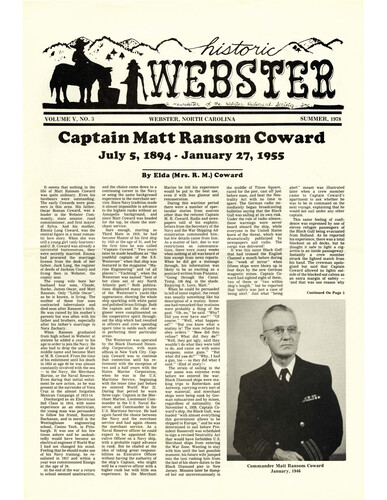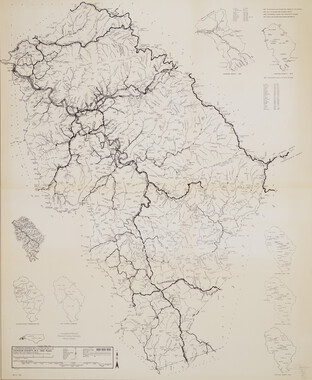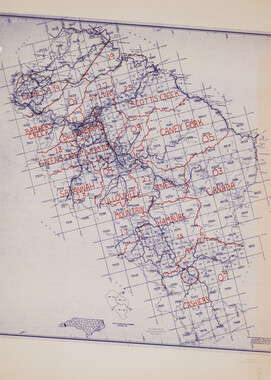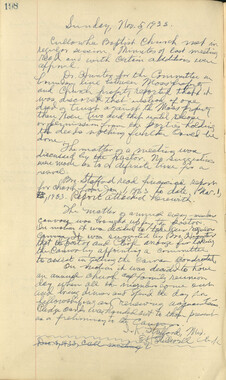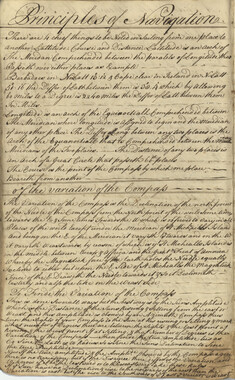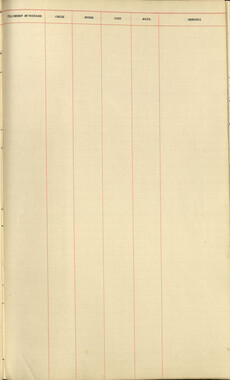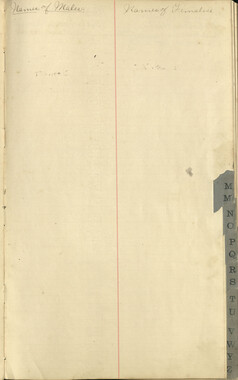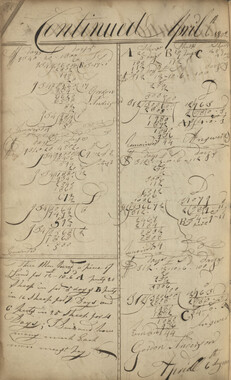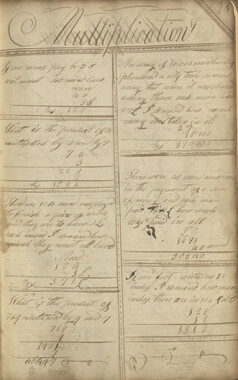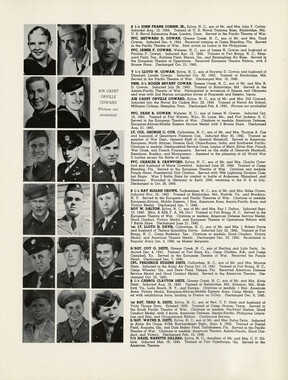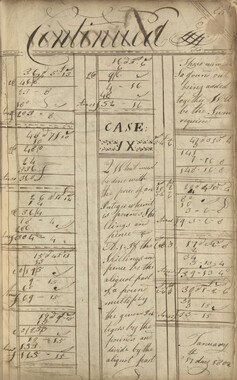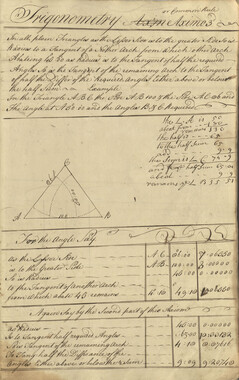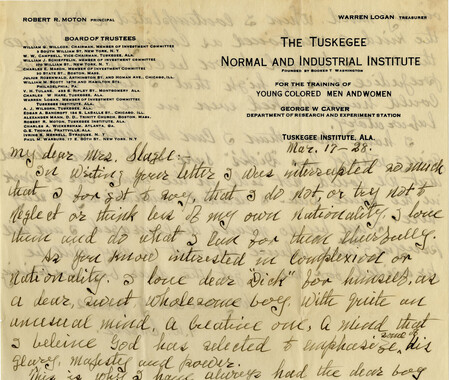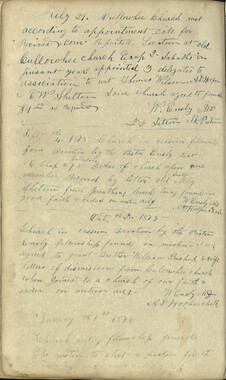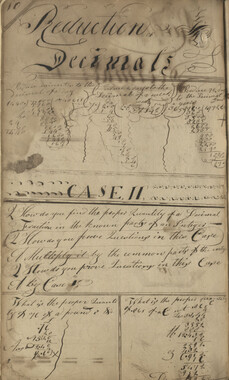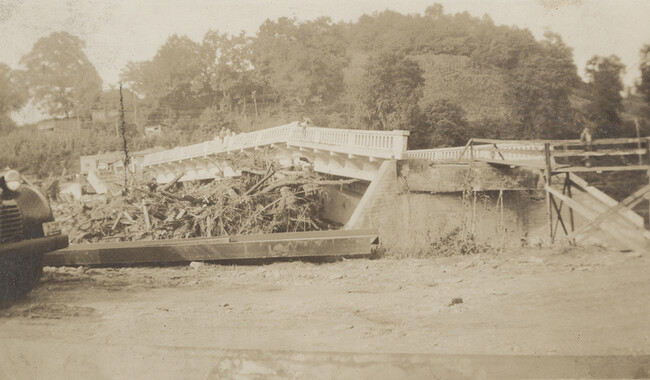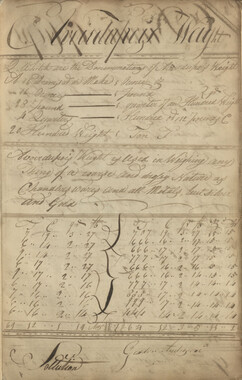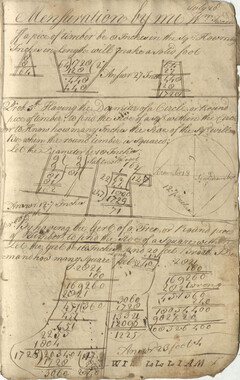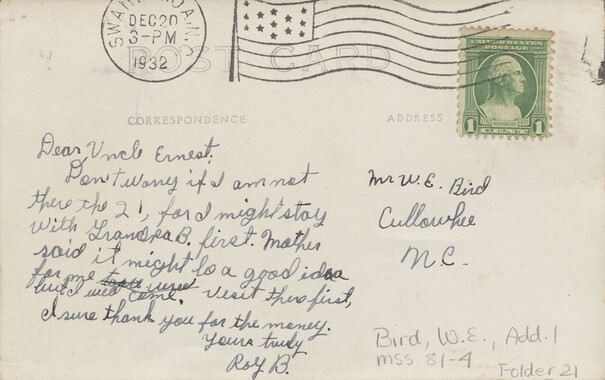Western Carolina University (20)
View all
- Canton Champion Fibre Company (2308)
- Cherokee Traditions (293)
- Civil War in Southern Appalachia (165)
- Craft Revival (1942)
- Great Smoky Mountains - A Park for America (2767)
- Highlights from Western Carolina University (430)
- Horace Kephart (941)
- Journeys Through Jackson (154)
- LGBTQIA+ Archive of Jackson County (24)
- Oral Histories of Western North Carolina (314)
- Picturing Appalachia (6772)
- Stories of Mountain Folk (413)
- Travel Western North Carolina (160)
- Western Carolina University Fine Art Museum Vitreograph Collection (129)
- Western Carolina University Herbarium (92)
- Western Carolina University: Making Memories (708)
- Western Carolina University Publications (2283)
- Western Carolina University Restricted Electronic Theses and Dissertations (146)
- Western North Carolina Regional Maps (71)
- World War II in Southern Appalachia (131)
University of North Carolina Asheville (6)
View all
- Carver, George Washington, 1864?-1943 (26)
- Masa, George, 1881-1933 (8)
- Niggli, Josephina, 1910-1983 (10)
- Whitman, Walt, 1819-1892 (10)
- Wilburn, Hiram Coleman, 1880-1967 (1)
- Allanstand Cottage Industries (0)
- Appalachian National Park Association (0)
- Bennett, Kelly, 1890-1974 (0)
- Berry, Walter (0)
- Brasstown Carvers (0)
- Cain, Doreyl Ammons (0)
- Cathey, Joseph, 1803-1874 (0)
- Champion Fibre Company (0)
- Champion Paper and Fibre Company (0)
- Cherokee Indian Fair Association (0)
- Cherokee Language Program (0)
- Crittenden, Lorraine (0)
- Crowe, Amanda (0)
- Edmonston, Thomas Benton, 1842-1907 (0)
- Ensley, A. L. (Abraham Lincoln), 1865-1948 (0)
- Fromer, Irving Rhodes, 1913-1994 (0)
- George Butz (BFS 1907) (0)
- Goodrich, Frances Louisa (0)
- Grant, George Alexander, 1891-1964 (0)
- Heard, Marian Gladys (0)
- Kephart, Calvin, 1883-1969 (0)
- Kephart, Horace, 1862-1931 (0)
- Kephart, Laura, 1862-1954 (0)
- Laney, Gideon Thomas, 1889-1976 (0)
- McElhinney, William Julian, 1896-1953 (0)
- North Carolina Park Commission (0)
- Osborne, Kezia Stradley (0)
- Owens, Samuel Robert, 1918-1995 (0)
- Penland Weavers and Potters (0)
- Rhodes, Judy (0)
- Roberts, Vivienne (0)
- Roth, Albert, 1890-1974 (0)
- Schenck, Carl Alwin, 1868-1955 (0)
- Sherrill's Photography Studio (0)
- Smith, Edward Clark (0)
- Southern Highland Handicraft Guild (0)
- Southern Highlanders, Inc. (0)
- Stalcup, Jesse Bryson (0)
- Stearns, I. K. (0)
- Thompson, James Edward, 1880-1976 (0)
- United States. Indian Arts and Crafts Board (0)
- USFS (0)
- Vance, Zebulon Baird, 1830-1894 (0)
- Weaver, Zebulon, 1872-1948 (0)
- Western Carolina College (0)
- Western Carolina Teachers College (0)
- Western Carolina University (0)
- Western Carolina University. Mountain Heritage Center (0)
- Williams, Isadora (0)
- 1700s (2)
- 1800s (13)
- 1820s (2)
- 1830s (2)
- 1840s (2)
- 1850s (4)
- 1860s (16)
- 1870s (9)
- 1880s (29)
- 1890s (9)
- 1900s (20)
- 1910s (23)
- 1920s (36)
- 1930s (38)
- 1940s (35)
- 1950s (46)
- 1960s (8)
- 1970s (27)
- 1980s (16)
- 1990s (1)
- 2000s (8)
- 1600s (0)
- 1810s (0)
- 2010s (0)
- 2020s (0)
- Buncombe County (N.C.) (10)
- Cherokee County (N.C.) (8)
- Graham County (N.C.) (11)
- Haywood County (N.C.) (9)
- Jackson County (N.C.) (151)
- Macon County (N.C.) (32)
- Madison County (N.C.) (1)
- McDowell County (N.C.) (2)
- Swain County (N.C.) (6)
- Appalachian Region, Southern (0)
- Asheville (N.C.) (0)
- Avery County (N.C.) (0)
- Blount County (Tenn.) (0)
- Clay County (N.C.) (0)
- Great Smoky Mountains National Park (N.C. and Tenn.) (0)
- Henderson County (N.C.) (0)
- Knox County (Tenn.) (0)
- Knoxville (Tenn.) (0)
- Lake Santeetlah (N.C.) (0)
- Mitchell County (N.C.) (0)
- Polk County (N.C.) (0)
- Qualla Boundary (0)
- Rutherford County (N.C.) (0)
- Transylvania County (N.C.) (0)
- Watauga County (N.C.) (0)
- Waynesville (N.C.) (0)
- Yancey County (N.C.) (0)
- Artifacts (object Genre) (3)
- Cards (information Artifacts) (2)
- Clippings (information Artifacts) (4)
- Drawings (visual Works) (1)
- Envelopes (23)
- Fiction (general Genre) (1)
- Letters (correspondence) (120)
- Manuscripts (documents) (11)
- Memorandums (9)
- Minutes (administrative Records) (2)
- Newsletters (39)
- Periodicals (39)
- Photographs (221)
- Portraits (54)
- Postcards (10)
- Publications (documents) (7)
- Speeches (documents) (1)
- Tintypes (photographs) (1)
- Aerial Photographs (0)
- Aerial Views (0)
- Albums (books) (0)
- Articles (0)
- Biography (general Genre) (0)
- Crafts (art Genres) (0)
- Depictions (visual Works) (0)
- Design Drawings (0)
- Facsimiles (reproductions) (0)
- Financial Records (0)
- Fliers (printed Matter) (0)
- Glass Plate Negatives (0)
- Guidebooks (0)
- Internegatives (0)
- Interviews (0)
- Land Surveys (0)
- Maps (documents) (0)
- Negatives (photographs) (0)
- Newspapers (0)
- Occupation Currency (0)
- Paintings (visual Works) (0)
- Pen And Ink Drawings (0)
- Personal Narratives (0)
- Plans (maps) (0)
- Poetry (0)
- Programs (documents) (0)
- Questionnaires (0)
- Scrapbooks (0)
- Sheet Music (0)
- Slides (photographs) (0)
- Sound Recordings (0)
- Specimens (0)
- Text Messages (0)
- Transcripts (0)
- Video Recordings (physical Artifacts) (0)
- Vitreographs (0)
- C.W. Slagle Collection (4)
- Sara Madison Collection (144)
- A.L. Ensley Collection (0)
- Appalachian Industrial School Records (0)
- Appalachian National Park Association Records (0)
- Axley-Meroney Collection (0)
- Bayard Wootten Photograph Collection (0)
- Bethel Rural Community Organization Collection (0)
- Blumer Collection (0)
- Canton Area Historical Museum (0)
- Carlos C. Campbell Collection (0)
- Cataloochee History Project (0)
- Cherokee Studies Collection (0)
- Daisy Dame Photograph Album (0)
- Daniel Boone VI Collection (0)
- Doris Ulmann Photograph Collection (0)
- Elizabeth H. Lasley Collection (0)
- Elizabeth Woolworth Szold Fleharty Collection (0)
- Frank Fry Collection (0)
- George Masa Collection (0)
- Gideon Laney Collection (0)
- Hazel Scarborough Collection (0)
- Hiram C. Wilburn Papers (0)
- Historic Photographs Collection (0)
- Horace Kephart Collection (0)
- Humbard Collection (0)
- Hunter and Weaver Families Collection (0)
- I. D. Blumenthal Collection (0)
- Isadora Williams Collection (0)
- Jesse Bryson Stalcup Collection (0)
- Jim Thompson Collection (0)
- John B. Battle Collection (0)
- John C. Campbell Folk School Records (0)
- John Parris Collection (0)
- Judaculla Rock project (0)
- Kelly Bennett Collection (0)
- Love Family Papers (0)
- Major Wiley Parris Civil War Letters (0)
- Map Collection (0)
- McFee-Misemer Civil War Letters (0)
- Mountain Heritage Center Collection (0)
- Norburn - Robertson - Thomson Families Collection (0)
- Pauline Hood Collection (0)
- Pre-Guild Collection (0)
- Qualla Arts and Crafts Mutual Collection (0)
- R.A. Romanes Collection (0)
- Rosser H. Taylor Collection (0)
- Samuel Robert Owens Collection (0)
- Sherrill Studio Photo Collection (0)
- Smoky Mountains Hiking Club Collection (0)
- Stories of Mountain Folk - Radio Programs (0)
- The Reporter, Western Carolina University (0)
- Venoy and Elizabeth Reed Collection (0)
- WCU Gender and Sexuality Oral History Project (0)
- WCU Mountain Heritage Center Oral Histories (0)
- WCU Oral History Collection - Mountain People, Mountain Lives (0)
- WCU Students Newspapers Collection (0)
- Western North Carolina Tomorrow Black Oral History Project (0)
- William Williams Stringfield Collection (0)
- Zebulon Weaver Collection (0)
- Church buildings (1)
- Dance (1)
- Education (13)
- Floods (3)
- Forced removal, 1813-1903 (1)
- World War, 1939-1945 (1)
- African Americans (0)
- Appalachian Trail (0)
- Artisans (0)
- Cherokee art (0)
- Cherokee artists -- North Carolina (0)
- Cherokee language (0)
- Cherokee pottery (0)
- Cherokee women (0)
- Civilian Conservation Corps (U.S.) (0)
- College student newspapers and periodicals (0)
- Dams (0)
- Folk music (0)
- Forest conservation (0)
- Forests and forestry (0)
- Gender nonconformity (0)
- Great Smoky Mountains National Park (N.C. and Tenn.) (0)
- Hunting (0)
- Landscape photography (0)
- Logging (0)
- Maps (0)
- Mines and mineral resources (0)
- North Carolina -- Maps (0)
- Paper industry (0)
- Postcards (0)
- Pottery (0)
- Railroad trains (0)
- Rural electrification -- North Carolina, Western (0)
- School integration -- Southern States (0)
- Segregation -- North Carolina, Western (0)
- Slavery (0)
- Sports (0)
- Storytelling (0)
- Waterfalls -- Great Smoky Mountains (N.C. and Tenn.) (0)
- Weaving -- Appalachian Region, Southern (0)
- Wood-carving -- Appalachian Region, Southern (0)
- StillImage (230)
- Text (200)
- MovingImage (0)
- Sound (0)
Historic Webster Vol. 5 No. 3
-
Historic Webster is a newsletter of the Webster Historical Society, Inc., created at the Society’s founding in 1974. The publication helped to serve the Society's mission of collecting and preserving the history of Webster, North Carolina. Webster, established in 1851, was the original county seat for Jackson County.
-
-
VOLUME V, NO. 3 WEBSTER, NORTH CAROLINA SUMMER, 1978 Captain Matt Ranso111 Co~ard July s, I894 · January 27, I9SS It seems that nothing in the life of Matt Ransom Coward was quite or.dinary. Even his forebears were outstanding. The early Cowards were pioneers in this area. His father, Oscar Boman Coward, was a leader in the Webster Com· munity, state senator, road commissioner, and first mayor of Sylva. And his mother, Emma Long Coward, was the central figure in a most romantic love story. When she was still a young girl (only fourteen ) and 0. B. Coward was already a successful businessman, they were secretly married. Emma had procured the marriage license from the desk of her father, Jack Long, the register of deeds of Jackson County and living then in Webster, the county seat. The young wife bore her husband four sons, Claude, Burke, James Oscar, and Matt Ransom. Only " Little Oscar", as he is known , is living. The mother of these four sons contracted tuberculosis and died soon after Ransom 's birth. He was raised by his mother's parents but was often with his father and brothers, especially after his father's marriage to Nora Zachary. When Ransom graduated from high school in Webster at sixteen he added a year to his age in order to join the Navy. He also had to drop the use of his middle name and become Matt or M. R. Coward. From the time of his enlistment untiiliis death in 1955 at age 60 he was almost constantly involved with the sea - in the Navy, the Merchant Marine, or the Naval Reserve. Even during that initial enlist· ment he saw action, as he was present at the surrender of Vera Cruz in the almost forgotten Mexican Campaign of 1913·14. Discharged as an Electrician 2nd Class in 1914, with some experience as an electrician, the young man was persuaded to follow his friend, Ramsey Buchanan, and to enroll in the Westinghouse engineering school, Casino Tech, in Pittsburgh. It was one of his few times ashore and he undoub· tedly would have become an electrical engineer if World War I had not changed his mind. Feeling that he should make use of his Navy training, he re· enlisted in 1917 and within a year was commissioned Ensign at the age of 24. At the end of the war a return to school seemed unattractive, By Elda (Mrs. R. M.) Coward and the choice came down to a continuing career in the Navy or using the same background experience in the merchant ser· vice. Since Navy tradition made it almost impossible to advance to the highest ranks without an Annapolis background, and since Matt Coward was headed for the top, he chose the merchant service. Sure enough , starting as Third Mate in 1919, he had become Master of his first ship by 1925 at the age of 31, and for the first time he was called "Captain Coward." Two years later he made headlines as " the youthful captain of the S.S. Westerner" when that ship was featured in the magazine " Ma· rine Engineering" and (of all places! ) "Yachting", when the Westerner was named " best of her class out of any North Atlantic port." Both publications displayed many pictures of the Westerner's yacht-like appearance, showing the whole ship sparkling with white paint and polished brass fittings. Both the captain and the chief en· gineer were complimented on the cooperative spirit throughout the ship which had resulted in officers and crew spending spare time to outdo each other in perfecting their particular areas. The Westerner was operated by the Black Diamond Steam· ship Corporation, with main offices in New York City. Captain Coward was to continue th3t connection until his re· tirement with the exception of two and a half years with the States Marine Corporation, when he was in the U.S. Maritime Service, beginning with the tense time just before we entered World War II. During that period he wore three caps: Captain in the Merchant Marine, Lieutenant Commander in the U.S. Naval Reserve, and Commander in the U.S. Maritime Service. He had again faced the choice between the Navy and the merchant service and had again chosen the merchant service. As a Naval Reserve officer he could expect to be appointed Exe· cutive Officer on a Navy ship, with a probable rapid advance in rank . But he chafed at the idea of taking great responsi· bilities as Executive Officer without having the authority of the ship's Captain, who might weB be a reserve officer with a higher rank but with little sea experience. In the Merchant Marine he felt his experience would be put to the best use, even if with less glamor and remuneration . During this wartime period there were a number of spec· tacular stories from sources other than the reticent Captain M. R. Coward. Radio and news· papers told of his exploits; letters from the Secretary of the Navy and the War Shipping Adminstration commended him ; but few details came from him . As a matter of fact, due to war restrictions on communica· lions, there were many weeks when nothing at a ll was heard of him except from news reports. When he did get a message through , his information was likely to be as exciting as a postcard written from Panama: "Going through the Canal. Temp. 106 deg. in the shade . Enjoying it. Love, Matt." When he could be persuaded to tell of some exploit, the result was usually something like his description of a mutiny. Some· one had remarked that mutinies were probably a thing of the past. "Oh, no," he said. " Why? Did you ever have one?" "Of course." " Well , what happen· ed?" "But you know what a mutiny is! The men refused to obey orders." " How did they refuse? What did they do?" " Well, they got ugly, said they wouldn 't do what they were told to do, and came on with some weapons, some guns." "But what did you do?" "Why, I had a gun, too - so they did what I said." (End of story!) The strain of sailing in the war zones was extreme even before we entered the war. Black Diamond ships were rna· king trips to Rotterdam and Antwerp, carrying every sort of war material; and merchant ships were being sunk by Ger· man subutarines and by mines, regardless of nationality. On November 4, 1939, Captain Co· ward's ship, the Black Gull , was loaded "with almost everything this government allows to be shipped to Europe," and he was determined to sail before Pre· sident Roosevelt was scheduled to sign a revised Neutrality Act that would have forbidden U.S. Merchant ships from entering the War Zone. Wanting to stay with him until the last possible moment, his future wife jumped into the taxi rushing him from the last of his shore duties to the Black Diamond pier in New Jersey . Minutes later he dump· ed her out unceremoniously in the middle of Times Square, raced for the pier, cast off just before noon, and beat the Neu· trality Act with no time to spare. The German radio im· mediately began broadcasting bulletins saying that the Black Gull was sailing at its own r isk. Under the rule of radio silence, these warnings were never heard aboard the ship, while everyone in the United States knew of the threat, which was dramatically publicized by newspapers and radio. The cargo was delivered! It was this same Black Gull that had crossed the English Channel a month before during the "week of terror" when fifteen ships were blown up in four days by the new German magnetic mines. Captain Co· ward had sighted eight of them, two of them or "two within ship's length," but he reported that 'safety was just a case of being alert. ' Just what " being alert" meant was illustrated later when a crew member came to Captain Coward's apartment to ask whether he was to be in command on the next voyage, explaining that he would not sail under any other captain. This same feeling of confidence was expressed by one of eleven refugee passengers of the Black Gull being evacuated from Holland. As he reported his experience, there was a total blackout on all decks, but he thought it safe to light a cigarette in an inside passageway. Instantly a crew member struck the lighted match from his hand. The crewman apolo· gized but said that Captain Coward allowed no lights out· side of the blacked-out cabins as an extra mar gin of safety - 'and that was one reason why Continued On Page 3 Commander Matt Ransom Coward January, 1946 Page 2, HISTORIC WEBSTER, Summer 1978 Elda H. Coward, Smoky Mtns .. 1942, 1st Trip To Webster Ransom Coward, 1st Trip To Webster With Elda Hibbard Coward, 1942 Oscar B. Coward, Father Of Ransom, At His Senate Desk In Raleigh, 1917 Capt. M. R. Coward About 1942 The Coward Cabin At Norton As It Looks Today, l978 Mrs. Emma Long Coward, Mother of Ransom, About 1888 Higdon Cabin, Norton,l948 Ransom As A Small Boy Ensign Matt Ransom Coward AtAge24 Captain Matt Ransom Coward Continued From Page 1 Captain Coward had never had his ship sunk.' But Captain Coward had to watch other ships sunk, some of them under the command of friends. Convoys were nervewracking experiences. In 1942 he was commended by the Swedish Military Attache and by the War Shipping Administration for standing by and rescuing the entire forty-two member crew of a Swedish ship which had just been struck by a torpedo and was sinking, with the subma-· rine almost certainly still in the area. The operation was .odescribed as "a praiseworthy exhibition of bravery and cOurage." Later Captain Coward was made Commodore of one of these huge convoys: responstble for every detail, including the exact t1me for each ship to cast off, the spacing of the ships in the convoy, and decisions for evasive actiOn against submarines. There is a snapshot of him at the end of that voyage, looking like a wraith, his eyes haunted , and his normally military posture sagging. He must never have slept. Orleans had had to be called off because his ship had been forced to sail before the time required for the publishing of the banns as required in that Catholic clly. His bride-to-havebeen had to return to New York to explain her week-end in New Orleans to all the friends who had seen her off with engagement parties! Now it appeared that the couple might have a little time together. Then, true to military tradition, every step ior sailing took twice its allotted time, as when the armorplate on the gun crew's quarters had to be re-planned and replaced because it had raised the temperature of the quarters inside to over 100 degrees. Consequently, the Coward's hotel room gave place to a small apartment, and Baltimore became a temporary residence, while one difficulty after another had to be laboriously overcome and the ship's captain had begun to develop ulcers. Finally the John W. Brown sailed, and Captain M. R. Coward became the first man to command an armed cargo vessel as he had been the last to sail an American cargo ship into the war zone before the United States entered the war. Page 3, HISTORIC WEBSTER, Summer 1978 • • • One of the less dangerous but terribly frustrating experiences of the wartime period was the story of the arming of the S.S. John W. Brown. In the early fall of 1942 Captain Coward was pul in command of the first merchant ship to be armed under a new policy of self-protection. The John W. Brown, just launched at the Bethlehem Shipyard in Baltimore, was to be the prototype. This was just a few months after his marriage. In November, 1941, Captain Coward had married Elda Hibbard after years of waiting out the Depression and then the difficulties of a war-torn world. One planned ceremony in New It was earlier in 1942, while waiting for the new ship to leave the dockyard , that the Cowards enjoyed a sort of delayed honeymoon by managing, in spite of wartime transportation difficulties , to get to Webster for Mrs. Coward's first visit. Neighbors, friends and relatives deluged the new bride with descriptions of what "a cute, bright little fellow Ransom was" and how many girls he had had. Somewhere the impression was given that he and Lawrence Frizzell had studied Latin or math (or both) as The Black Gull. under the command of Captain Coward, was a prime target of German submarines. Captain M. R. Coward 1925- Age 31 First Regular Command S.S. Westerner vacation pastimes. And he had gone into partnership with some other boy and operated an old mine while still in high school. A recently unearthed scrapbook picture of Ransom hoisting two girls in a mine bucket seemed to prove that story. On that vacation trip the time was divided between the old home place in Webster and fishing expeditions at the Warren Alexander Camp in Whiteside Cove with Rogers Coward, a half-brother of whom both Cowards were extremely fond. Six years later and several other mountain vacations, they bought a fishing camp in Norton, for which Rogers had scouted the entire county. This was later to become their home. After the war Captain Coward transferred to a shore job with the Black Diamond Company, and from 1943 to 1950 he was: first, Port Captain and then Marine Superintendent. Simply stated, his duties were to take charge of all Black Diamond ships when they were in East Coast ports. This required a good deal of traveling, but at least he was based at home. At this point he made the astonishing statement that he had always wanted to paint! With an apartment in the middle of New York 's Greenwich Village, it was easy to find a studio nearby where art lessons were available. Both he and his wife enrolled, but he was the more industrious and dedicated. He spent many evenings at his easel with a daylight lamp, and the couple's favorite week-end outings became sketching trips to Central Park, Staten Island or up the Hudson. Captain Coward went on to classes at the notable Salamagundi Club on lower Fifth Avenue and eventually exhibited oil paintings at the National Arts Club and the Village Art Center. He always said that he was most flattered when one of his ship paintings was stolen from a Village exhibit. Later, hearing that the painting had been seen as the chief decor-ation in a bar, his pride increased! He did some really striking paintings of ships and the sea, and one of the best is of that armed merchant ship, the John W. Brown, machine gun and all. Another favorite is a sun-filled painting of an African village, based on scenes he had enjoyed when he had taken the S.S. Eldara up the coast of Africa in 1936. He had been fascinated by " Zululand" and had uncharacteristically brought home a great many Mementoes: a heavy bow with sharp hunting arrows, a lovely carved ebony head, and a spotted calfskin used in trade and as clothing. But perhaps his most successful painting is a dark seascape with' moonlight faintly outlining the silhouettes of a distant convoy against the horizon. While it is a peaceful scene at first glance, it somehow conveys a haunting sense of danger. In 1950 Captain Coward, at the height of his career, unexpectedly asked his wife, "What would you say if I just quit working now, without waiting for retirement? We could spend a year here in New York, just enjoying it, and we could fix up the Norton camp for a yearround home. But if we should run out of money before my Navy retirement pay begins in 1954, you will have to get a jobbecause all I know how to do is run a ship!" What a happy five years those were! New York was savored as by visitors, with walks through Central Park and out-of-theway sections of the city, trips to points of interest, meals at interesting restaurants, visits to art galleries and exhibits, and always sketching and painting. Meanwhile the Norton camp was being transformed into a home, and the move was made in 1951. Lieut. Commander Coward had become Commander Coward in the Naval Reserve before leaving New York, and a few months after moving to Norton he helped to organize in Sylva the U.S. Naval Reserve Unit NRCC 6-36, which later moved to Cullowhee. He served as Commander of the unit until the summer before his death, fajthfully preparing for the weekly drills and regularly taking refresher courses at the Charleston Naval Base. Members of the unit served as pallbearers when he was buried from the family church, the Methodist Church in Webster, and was interred in the Coward plot in the Webster Cemetery. Besides the Navy, two other organizations meant a great deal to Captain Coward. In 1945 he had been made a member of the Marine Society, founded in 1769 with a charter from George III, and including in its membership rolls such famous names as both Alexander Hamilton and Aaron Burr, as well as some of the most illustrious mariners in United States history. Also, strangely, he was a member of The Lambs. This famous old actors' club had once chartered a ship to sail around the world. The members had become so fond of the captain of their ship that they had admitted him to the club, and from that date on there had always been one sea captain on their rolls. Captain Coward was elected in 1936 upon the death of the previous sea-going member, and he took a great deal of pleasure in their meetings and the use of their clubhouse in the center of the theatrical section of New York. He would have been pleased to know that at his death they sent his widow a memorial scroll signed by dozens of members, including Harry Hershfield, Eddie Foy, Jack Sheehan and Dennis King . Captain M. R. Coward was a modest man and a quiet man. Without making much fuss about it, he loved his country and he loved these mountains. He did say that these years in Norton had been the happiest of his life. •••••• Page 4, HISTORIC WEBSTER, Summer 1978 November, 1769, a company of thirty-two persons assembled in the long room of the Exchange, then at the foot of Broad Street in New York City, to consult together about forming themselves into a society for the relief of distressed shipmasters, or their widows and children, and for the promotion of maritime knowledge. The meeting was organized by Leonard Lispenard, Esq., who became the society's first president. A committee was appointed, and after several meetings, articles were agreed upon and presented for approval by Capt. Thomas Randall, The author of "Captain Matt Ransom Coward" is Elda Hibbard Coward, Captain Coward's widow. The daughter of Eva Belle Lacy Hibbard and Edwin Lewis Hibbard, she was born in Warren, Pennsylvania but grew up in Jamestown, New York near the Chatauqua Assembly grounds. There she had th' privilege of attending concerts and lectures of that famous organization. Elda finished high school in Jamestown in 1920, received her l\ .B. degree from Mount Holyoke College in 1925, and her M.A. from New York University in New York City. Mter graduation from Mount Holyoke, she became a private secretary to F. W. Gurney of Jamestown and Long Island. Gurney was owner of the Gur- THE MARINE SOCIETY OF THE CITY OF NEW YORK the second president of the Association. The rules were adopted and were the basis of the charter granted in 1770 by George III. The Society flourished and carried out its dual purpose of charity and patriotism. Many illustrious names are found in its membership. Thomas Truxton, who commanded a privateer in the Revolution, was the first captain appointed by Washington in the regular navy. Robert R. Livingston, John Cruger, Phillip Livingston, William Bayard, and Leonard Lispenard were the five delegates from New York to the first Colonial Congress. Aaron Burr, General Clinton, an early governor of New York, Alexander Hamilton and George Washington were on the Society's roll. In 1788 the Society participated in a public procession in which a 32 gun frigate, manned by 30 seamen, was drawn through the streets to signify the organization 's approval of the proposed Constitution of the United States. The 13th day of April, 1789 was another red-letter day: for the barge which conveyed Washington from Elizabethtown Point to New York, here to be inaugurated as the first President of the United States was rowed by thirteen captains, with Captain Randall acting as coxswain. During the first years of its existence, the Society petitioned for the erection of lighthouses on our coasts and the placing of buoys in our channels. Many means of preserving ship timber were tested. Widows and orphans o! deceased members were assisted financially. The beginning of the Nineteenth Century marked the founding of "The Sailor's Snug Harbor," now one of the most efficient benevolent institutions Elda Hibbard Coward ney Ball Bearings, now the Marlin Rockwell Corporation of Long Island. In New York City, Elda became a secretary to Theresa Mayer Durloch, founder of World Peaceways and of the private progressive Durloch School (now Emerson School) of New York City. Elda later taught five years in that school. The advertising departments of two corporations, the Lipton Tea Company and the Lightfoot Schultz Soap Company, both of Hoboken, New Jersey , furnished Elda with two of the most rewarding jobs of her career. She was especially fond of the Lightfoot Schultz Company where she had congenial surroundings and was fast learning the advertising business. Unfortunately, this job to which she had commuted daily from New York City folded because of the Great Depression of the '30's. While associated with Hoboken, she became the membership secretary of the Hoboken Community Y. This organization (not to be confused with the YM or YWCA) had over a thousand members and consisted of both men and women. After her marriage to Captain Coward, Elda gave up full time work. But considering the time, World War II ; the place, New York City; and the person, Elda Hibbard Coward; she was not idle. That state would be an impossibility for her. While her husband was away for long periods at sea, she aided in the war efforts, did private tutoring and worked part time as a psychiatric therapist for the late psychiatrist Dr. Edward Liss of New York City. She had known him when both were associated with the Durloch School. When Captain and Mrs. Coward retired to the Norton Community of Jackson County in 1951 they quickly fitted into its life and activities. Elda helped to found the Norton Community Organization and the Norton Homemakers Club. The Norton Ridge Runners, formed by her at popular request, began initially for the local teenagers as a "Something to Do" program. Now this combination recreation and work group which includes ah ages from kindergarten to college is active in community affairs. It is still lead by Elda and is still going strong. In 1954 the Cowards formed in our land. Today the Marine Society of the city of New York has some 350 members. It still supports its charitable program for children and widows of deceased members, and promoted advancement of maritime knowledge. It maintains a maritime and historical library of 1000 members. Its publication is the "Manifest." The annual dinner is held the second Monday in April. Taken from: The Marine Society of the City of New York, in the State of New York. the Mountain Realty Company, an extremely profitable business venture , of Norton and Cashiers. This lasted until Elda sold it in 1965. Today, this woman of seemingly boundless energy and many talents is a member of the Cullowhee AAUW, the Webster Historical Society, the Norton Homemakers Club. She serves on the board of the HighlandsCashiers Hospital and is Lay Leader and Lay Speaker for the Cashiers United Methodist Church. In the midst of all this she finds time to spend part of the winter in her home area of Jamestown , New York, or in Florida, keep in contact with and entertain countless friends , and support and attend area cultural events. Mrs. Minnie Wild Observes 95th Birthday By Mrs. Frank Hyatt, Sr. M~s. Minnie Norton Wild, formerly of Webster, resides by choice in the Methodist Home Wesley Nursing Center in Charlotte, North-Carolina. On June 9, 1978, she celebrated her 95th birthday at the Greensboro home of her grandson , Dr. David Sillmon. She was married to Julius Jacob (Jake) Wild in the Webster Methodist Church December 16, 1903. (A complete account of this wedding appears in the summer issue of 1974 "Historic Webster." ) Mrs. Wild has two daughters living: Mrs. Oberia Hyatt of Bryson City, and Mrs. Nell Sillmon of Pleasant Gardens; four grandchildren and eleven great grandchildren. She graduated from the Normal Department of the Cullowhee School, now Western Carolina University , in 1899 and taught in the Jackson County public schools. While living in Webster, she became the first president of the Webster School PTA when it was organized in 1930. She was also a member of the local We regret the deaths of Felix Picklesimer and Miss Dorothy Williams. Felix, a charter member of the Webster Historical Society died June 26, 1978. Miss Williams, a charter and life member died April 6, 1978. ** COOKBOOK Copies of the Webster Cookbook, 11rice $6.25 plus .75 for mailing, are available from Mrs. Joe Rhinehart. Webster, N.C. 2877H. ** school committee for a number of years. Mrs. Wild was very active as a member of the Webster Methodist Church and of the Women's Society, then called the Ladies Aid. At church suppers and other community affairs her justly famous white cake often made its appearance. The recipe for this cake is in "The Webster Cookbook", page 73. Mrs. Wild 's grandparents were Nathan and Jane Rogers Coward and her parents were Will and Sallie Jane Coward Norton of Cullowhee. At the time of her marriage, her father was sheriff of Jackson County and the family lived at the sheriff's official residence, the county jail in Webster. A charter member of the Webster Historical Society, Mrs. Wild has maintained contact with kin and friends in this area. Until very recent years she was always present at the Coward Reunion which began as a celebration of her Grand. father Nathan Coward's birthday. Mrs. Minnie Wild Age 94, October 1977 Wesley Nursing Center Methodist Home Charlotte, N.C. The Green Mountain 1942 Page 5, HISTORIC WEBSTER, Summer 1978 Early School Buses Alan was a junior at Webster High School in 1960, when this article was written for the Ridgerunner, the school 's publication. Every school day in this year of 1959, five, large yellow school buses with maximum capacities ranging from sixty to sixty-eight people roll into the parking area at Webster High School. One adult and four students man these buses to Webster and one student drives to Savannah. Unfortunately, the seating capacities of these buses are somewhat less than the maximum number riding, and a few students have to stand in the aisles. With the exception of one, the buses make at least two trips twice daily. But these modern machines, with their excellent heating systems and comfortable seats, are a far cry from the early (1924) buses that chugged into the school parking area and stopped with squeaks and splutters. These early vehicles were not the sleek, yellow ones we know today. They resembled big black boxes perched precariously on high, woodenspoked wheels. The seats were bench-type and extended along the walls and down the center. The only heat provided was that coming off the exhaust pipe. Dangerous? Of course it was. Even with fresh air pouring in from the numerous crevices, riders sometimes became ill from inhaling poisonous fumes. As best as some of the early drivers and riders can recall , John Dillard was the first By Alan Allman regular adult Webster School bus driver hauling students from Lovesfield, Fairview Road, the mouth of Locust Creek, and Little Savannah. Approximately thirty-five people were crowded into his small 1923 Ford bus. Dillard's first run was through Lovesfield, up the Fairview Road, and to the mouth of Locust Creek. After delivering this load to school, he traveled to Little Savannah. However, he made this run only in the winter or when the road conditions made it impossible for the bus coming from Big Savannah to also make its Little Savannah run. Mr. Dillard drove during the school year of 1924-1925. After he resigned, Ralph Tatham, another adult, drove part of the school year of 1925-1926. Carl Allman completed that year in a new 1926 Corbitt bus. During the school year 1926-1927, Joe Rhinehart, Jr. , a student, drove. The first bus driver on Big Savannah was Leeman Tatham, a student, who started in 1924 with a new Dodge bus, and brought all the high school students, at one load, to Webster. In the fall, when the roads began to get muddy and slippery, Tatham and Dillard exchanged buses. The choice seats on this bus were the two front fenders. Often as many as eight boys rode on the outside of the bus; . one on each front fender, two on each running board, and two on the rear step. The seats were really very handy ; because, if the bus stuck in the mud (and it usually did), the outside riders pushed it out. But, when the winter set in and roads became very bad, this bus c< ;Jd not travel at all. Some of the students then dropped out of school. A few walked, and those who could afford it, boarded at Webster. After Tatham quit, Wiley Collins, another student driver, took over. During these years approximately thirty-seven pupils rode the bus. A total of about seventy-two pupils used bus transportation at both Webster and Savannah. Now, about 609 students are brought in this manner. Driving a bus in the early days when the roads were, in bad weather, nothing but mud was indeed a toilsome chore. A student driver made only $20.00 a month ; and an adult only $40.00. These salaries (if they could be called such) were paid by the county. Now a student driver with a good bus on an asphalt highway makes $45.50 a month. The state pays $25.00 and the county, $20.50. An adult driver receives $51.50 of which the state pays $25.00 and the county, $26.50. The early bus drivers did not have to have licenses or even license tags. Now, bus drivers have to pass strict written and road examinations, and their buses have permanent license tags. The oldest bus driver still in service at Webster is William Frizzell, who started driving a 1937 Ford in 1939. His driving career, from 1939 to 1959, has not been continuous, but Bill has driven many miles and plans, he says, to drive "a few more.'l WAR SHIPPING ADMINISTRATION WASHINGTON Captain M. Coward Master, SS GRE&~ ],;QUNTJ..IN cjo Federal Marine Corp. 90 Broad Street New York, New York Dear Sir: August 10, 1942 Advices have reached this office of the commendable assistance rendered by yourself and the members of the crew of the ss GREEN .M.OUN'i'A.!N to the Swedish MS TL:>'NAREN, the latter vessel being sunk by a submarine. Such exhibitions of bravery and courage are indeed praiseworthy and are appreciated by the War Shipping Administration. For your information, we are attaching hereto copy of letter dated July 24, 1942, addressed to the Director of Naval Intelligence of the Navy Department by Major K. Wessel, Military Attache of the Swedish Legation in Washington, on the subject, which, we know, you will find of interest. Very truly _zours, ~~~ F. Devlin 9-lperintendent of Operations Page 6, HISTORIC WEBSTER, Summer 1978 Update On Higdon Cabin The Foxfire Fund, Inc. June9,1978 I I Some Of The Exotic Names At Our Sawmill Mrs. Louise B. Davis Editor , Historic Webster Webster Historical Society, Inc. P.O. Drawer W Webster, N.C. 28788 Dear Mrs. Davis, Thank you for your continued interest in our program. Yes, we have moved out of the Rabun Gap Nacoochee School since it went completely private but we now are involved with community students in the newly consolidated Rabun County High School. We all felt that our work should concern students who live in this area and therefore the move in June, 1977. The Foxfire Center with all the log buildings is used in conjuction with our work at the high school; students come to the center to work on projects, etc. As to your other question, the Frank Higdon cabin is still incomplete. Due to several problems, our construction schedule has been delayed; the house still looks pretty much like it does in the pictures you have. However, we still have definite plans for this cabin ; we want to (Editor's Note) Rabun Gap, Georgia 30568 furnish it much like a cabin would be furnished in the early days , when people were first in this area. It will include old furniture such as a rope bed, cornshuck bottomed chairs, etc. In essence, the Higdon cabin or as we know it; the Savannah House, will become a museum - one of several buildings to be used for museum purposes. We are very proud of the Savannah House and are going to great lengths to make it beautiful and useable to the students and others we serve. Thank you again for helping us to find a concise, factual history. That history will one day be published for others to see in a book from Foxfire Press. If you have any other questions regarding this particular log building or any other aspect of our operation , please don't hesitate to call upon me. Sincerely, Paul F. Gillespie Foxfire A full account of the joint effort of Foxfire, and Historic Webster in the story of the Frank Higdon (Manson Wilson) cabin was published in the Spring, 1976 issue of Historic Webster. Paintings By Painting that was stolen from the Village Art Center in Greenwich Village - 1948 African Village By Elizabeth Keyes Blackwook Lumber Co.based its North Carolina operation at East La Porte. Old Blackwood had first operated at Pardee, Va. which was not really so far away that it could be considered "exotic." But, the name of our town "East La Porte" must hav originated in the old country across the water as it is apparently French language. Several learned people have speculated upon this name and have come up with several assumptions. One such assumption , not widely circulated on account of its identity with the mystical in this age of material values, is that the early French Voyageurs established their fur trading post on the sacred ground of the native Indian fur trappers. The French designated the place "East La Porte" after the Eastern Gate of Jerusalem which was sealed when Jesus was crucified. That Eastern Gate is never to be opened until the Second coming of Christ. We do not know what the ancient name for the Tuckaseegee River at the joining with Caney Fork was, so we still use the French name, "the Eastern Gate .. " Perhaps it is very well named as miracles still happen there and have been written in other books. We do not know the name of the supreme deity of the ancient Ones. He was a Father-Image God, a slanty eyed Giant known as "Judaculla/ ' or as the Cherokee spelled it, "TsulKalu." It is interesting to note the last syllable "Kalu" means "beautiful" in ancient Greek. The interpretation of "judaculla" by the Spanish Conquistadors was "Qustzalcoati," who dominated much of the secular thinking of Mexico before Cortez. Even in these modern days , we cannot quite decipher the meaning nor origin of such obscure names as "StonyChoe," one of our Railroad hands. We know very well however, the origin of NewBern McArthur Davison's name. "Davey" was Mr. Davison's most used name ever since he returned from six years active duty in Europe with Canadian General Staff during the First World War. When Davey was ">orn on the Bay of Fundy Coast of Novia Scotia, a U.S.A. vessel capsized at his father 's northern boundary, Scotsman's Neck. Some of the crew perished but among the survivors brought to Judge Davison's homestead by the rescue party was the Captain, McArthur. The vessel which disappeared into the angry northern sea had been commissioned out of New Bern, North Carolina. So, Judge Davison named his baby boy after the home port, ''NewBern,'' and Captain McArthur, to commemorate that eventful, stormy night. NewBern McArthur Davison never remembered the Captain, but years later , he visited NewBern, N.C. This was very near the end oi his life, but before the beautiful restoration of the exquisite Tryon Palace which today keynotes NewBern's renaissance of elegance. Mr. Davison would admire his name· sake town today. When he sa" it , NewBern was not so pretty. These stories lend credence to the Oriental belief in Life's cycles, one circle within another into infinity. In this instance, NewBern Davison's brotherin- law, Mr. Keys , had owned a plantation place near NewBern, N.C. since before ever knowing the Davison family. And, as Treasurer of Mr. Keys's Blackwood Lumber Co., NewBern was assigned duties at the plantation during the resettling of employees of Keys enterprises at the time of the Great Depression. Matt Ransom Coward Village Church Still Life Page 7, HISTORIC WEBSTER, Summer 1978 Grimshawes And Aunt Lena Mrs. Frances Baumgarner Lombard It was the year 1911 that Aunt Lena and Uncle Warren Alexander and small baby, May, came home from a two year sojourn out west. At that time they bought the old Grimshawe homestead, Later they gradually acquired all or most of their vast land holdings in Whiteside Cove. Both were young, strong and vigorous, and had all the optimistic visions that belong to youth, plus grim determination. With all this they took over the gigantic task of running the big farm and carrying on the hoarding house the Grimshawes started in the 1880's. The place was ideal in its natural setting, with sharp grassy hillsides reaching toward the mountains beyond and down to the level bottom land that lies along the wild Ch~tooga River. In those days these pure fresh-water streams were alive with native trout, and here was the answer to a nature lover's dream, and a fisherman 's paradise. The hard work that went along with an establishment of this size held no qualms for the Alexanders. They faced each day with the same lighthearted cheerfulness. Aunt Lena was a goodnatured soul, warm and jolly. Her winsome personality ·and · cheerful disposition was something to be envied. She had a ready laugh, and the art of passing a clever little joke with everyone she met. The many years she was in the tourist business she became widely known and fondly loved. Uncle Warren was equally as vibrant a personality with a pleasant attitude toward life and his fellowman. He was community minded, a loyal Democrat, a natural leader who stood for progress and always used his influence toward making a better community. Although their work was an endless cycle, they were never too busy to pleasantly pass the time of day with any neighbor at the door or at the post office. The two daughters, May and Anne (later Mrs. May Passmore and Mrs. Anne Early) growing up in this warm homey atmosphere, developed the same winsome personality and both are kind, understanding, gracious ladies. They make their home in Cashiers Valley. I suppose life went along slowly and smoothly for the Alexanders in the horse and buggy days; the years they lived here between 1912 and 1920. The good old slow days when there was time to meet the Iowlanders at the depot, either at Lake Toxaway or Walhalla. This was done in a buckboard wagon, a buggy, or maybe an up-to-Oate surrey with fringe around the top. It was more than a two days' journey to Walhalla or Seneca and most people came prepared to spend the greater part of the summer, and returned to meet the train in like manner. In 1921 the Alexanders suffered a drastic setback. While the man of the house was away at work, and the girls in school, this primitive old home caught on fire and was completely destroyed, while Aunt Lena stood by helpless and alone. She watched through Excerpted: From the Hills of Home in Western North Carolina tear-blurred eyes as the leaping flames and dense smoke took away everything but her memories. But with typical enthusiasm they went straight to the job at hand and soon had a new, bigger and much more modern house to take the place of the primitive one. A little later the first automobiles started coming through the Cove, and with their arrival the tempo at Alexanders increased at a rapid rate of speed. People from many different walks of life, largely from Charleston and other parts of the deep South found their way into this sheltered area. They came back year after year and became as one big happy family. One lady from Jacksonville, Fla. told me she brought her children there for eleven consecutive summers. Others stayed even longer. Lots of folks remember the old retired Judge Bennett. He originally came from Scotland to Columbia, S.C. then found his way into the peaceful simplicity of our isolated hills. Here he spent his sunset days, winter and summer, fourteen years in all. He lived in his own little cottage and took his meals at the big house. Like the psalmist of old I like to think the Judge gathered strength for his soul from daily lifting up his eyes "unto the hills". He left in 1930, only when he was too sick to remain longer in his beloved retreat. He died soon after and was taken back to Columbia for burial. One of the main attractions at Grimshawes was the sliding rock. This is a small waterfall a short distance upstream above the Chattooga River bridge on 1107. It's perfect for sliding down the face of the falls into the placid pool below. Here the houseguests of all ages would gather to participate in the healthful , wholesome entertainment. There waS no generation gap to bridge at the sliding rock. Old and young, laughing and shouting, would slide down the steep face into the sparkling, hone chilling water below. This was equally a popular sport at night when the stream and woodland were bathed in the soft light of the big yellow moon. Unfortunately this fun spot has been closed to the public for several years. One man who spent the greater part of his boyhood summer days there told me that the highlight of any day was when the supper dishes had all been put away. Then Aunt Lena would relax in an easy arm chair on the old porch. As the cold night air swept down from the mountain to cool her aching body she would entertain her guests with mountain folklore and goose-pimple ghost stories. Aunt Lena had a wonderful memory and a natural knack for telling old tales. While the tour1sts came and wer.t, the little Grimshawes post office started in 1878 was still going strong. The two mails a day added to the busy farm and household chores, and many people dropped by to pick up mail, buy money orders, etc. As far as I know, there was never a carrier for the Bullpen section. This mail was always picked up at the office by various persons and distributed throughout the settlement. But it was a rare cold day when we didn't have two mails through Whiteside and Horse Cove. Way back in the early days the carriers walked from Cashiers to Highlands. The first carrier the writer remembers was John Passmore. He was responsible for making the 'Passmore trail' straight up the Highlands mountain. It was steep as a horse's face. Parts of this old trail are still visible, but soon will be gone and forgotten. After John Passmore's untimely death his boys carried the mail for many years. In patronized Grimshawes or Alexanders for so many years heard the depressing news that the old place was once again up for sale. It had touched the lives of scores of people, and this time when it changed hands the doors and grounds would be closed to the public for all time. In the early summer of 1946 after a last fling with the faithful old crowd, Uncle Warren and Aunt Lena gave up the old home and its peaceful way of life and moved into the village of Cashiers. They carried on the same line of work but I feel sure it was never the same, as they were too old to Aunt Lena and the smallest U.S. Post Office order as they came by age, Chris, Chuck, Homer and Dewey. They rode on a mule or horseback. Hydrick Hunter was a carrier for a while in the 1920's. The first motorized vehicle to be used through here belonged to Homer Passmore. It was a 1927 Chevrolet truck and was almost 'hand made' - that is he built the cab and the bed from new lumber. That was a red letter day for the Cove when he drove through. Later on in the thirties other carriers were Claude McCall, Frank Henry, and Dan Henry. Dan was our carrier for many years, and while he was in service the mail line was re· routed and the morning mail went back of the mountain to Highlands and only came through the Cove in the afternoon. In 1946 when the Alexanders sold the old home, the little post office was moved about a mile down the road to their daughter May's home, Mrs . Dewey Passmore's. May did an excellent job as post mistress until around 1951. When she moved away, once again the little post office was moved a little farther down in the Cove to the horne of Tom Picklesimer. Tom and his wife Georgia kept •the office until it was discontinued and the doors closed forever on May 31, 1953. Mrs. Greta King has among her cherished possessions a postal card from Tom Picklesimer postmarked the day this little office that had served so many people so long and so well went out of existence. Though Grimshawes post office was said to be the smallest in dimensions in the U.S., it might be surprising to know just how far it reached out in mileage. I'm sure it was with sinking hearts that the people who had make good transplants even though the distance was short from the old home to the new one. By the early sixties Aunt Lena had walked many miles down the corridors of time, but she was well into her eighties before the ravages of time overtook her. I had the privilege of seeing her in the HighlandsCashiers hospital not many days before she left us. Her face and hair was as snowy white as the pillow she lay on, but the old time sparkle was still in her flashing brown eyes, and once again her merry laughter rang out in the quiet little room. A few days-rater on a bright April day she was laid to rest in the little cemetery on the hill, in the land that gave her birth and life. Some years after Aunt Lena's passing, Uncle Warren was married to Mrs. Dorthy Elyea of Atlanta, Georgia and Cashiers. They alternated living in the two places. My last memories of Uncle Warren are at the Cashiers Baptist Church where he was a regular attendant when he was in the community and his health permitted. He listened attentively to the message of the hour, and cordially greeted each old neighbor. This may or may not be well known; but I have it on good authority. Without sounding a trumpet Uncle Warren was known to give generously of his bounty to various worthy charities. 41But when thou does alms let not thy left hand know what thy right hand doeth". St. Matthew 6:3. Uncle Warren too lived to a ripe old age. He passed away January 31, 1972 after several months of declining health. His body was brought back and placed beside his longtime companion in Greens Creek Cemetery. Another old timer gone down the valley and the likes of them we'll never see again. On a cold overcast day Uncle Warren's body merged with the good earth in the land where his heart had always been. Mrs. Frances Baumgarner Lombard was born June 12th, 1915 in Whiteside Cove, youngest daughter of the late Rev. Frank and Molina Galloway Baumgarner. She is a great grand daughter of Col. John Heywood and Sarah Whiteside Norton Alley, pioneer settlers in the Cove. Frances has lived all except three years of her life iri the land of her heritage and for the past twenty seven years has had the privilege of living on land that was bought from the Indians by her great, great, grandfather Barak Norton. She was married to Everett G. Lombard of Whiteside Cove in 1939, and is the mother of three children. Sliding Rock at Alexanders Whiteside Cove, 1942 Webster Gets New Postmaster WEBSTER- A new postmaster for Webster has been announced by the Asheville Sectional Center manager, H. V. Campbell. Rodney A. Warren, 30, a native of Taylorsville and distribution clerk at Hickory for the past five years, received the appointment July 29. Dallas Stephens, the former officer in charge, has returned to his regular post at the Cullowhee Post Office. Warren, who has completed a number of postal management courses, will receive a salary of $17,500 at the Webster office which has annual receipts of $6,000. Warren and his wife, the former Patsy Little, have three children. Reprinted from Asheville Cit· izen - August 4, 1978. Summer 1978 - --- ----~ ~ ·- -- ~- · lP 43 - • cCA\ Cia~· Mint> - ~--=::---_ Nit: kt•l MinP A GUIDE TO THE MAP OF WEBSTER 1900- 1910 I. Poke Allman Home (later, Cole Allison's) 2. Webster School Building 3. Felix Alley Home 4. Methodist Church 5. Methodist Parsonage 6. Mountain View Hotel 7. Coward Hotel 8. Drug Store, operated by Will Rhinehart 9. General Store 10. Court House 11. Oscar Coward Store 16. Dr. James Candl er Home (later, Mrs. Gene Allison's) 17. Leatherwood Home 18. O.B. Coward Home 19. Jud ge Cannon Home 20. Frady Blacksmith Shop 21. Joe Hooker Home 22. Henry McKee Home 23. Lewis Broyles Home 24. John T. Love Home 25. Site of Webster Academy, which burned in 1895 / 12. Coleman Cowan's Law Office 13. Terrell Home (later, Hedden Home built on site) 26. Sherrill Home 14. Dick Wilson Home 15. Masonic Lodge and Allison 's Store 27. Owned by Mrs. Sophia Coward and rented to others This is the third attempt at getting a correct map of the village of Webster in its early days. Thanks to the keen memory of Col. Lawrence Frizzell, who corrected some of the errors of the second version, we have this third and last. Cowan, has been retained. The time span has been enlarged to take care of the changes brought by people moving in and out. Drawer W / / / / _.... .... _,...///./,...- ..-:::'/:/ - -The Town ~)f Webster ~ :------ -1900-1910 --- / , _: ./ / ... . ;" r// :,.... ,..... ,. / / - - ...- - / / / 28. Judge Moore Home 29. Allison and Broyles Store 30. Small Store 31. Jail 32. Town Well and Public Square 33. Sch reiber Home 34. Post Office 35. Tuckaseigee Bank and Jackson County Printing Office 36. Spake Home (la ter,Andy Allison 's Home) 37. Dr. Tompkins Home 38 River Bridge 39. Dr. Self Home 40. Baptist Church 41. Brick Plant ~ ~-;:.....>< WEBSTER ---- / 42. J. W. Cowan Furniture Shop 43. Lawrence Cowan Home 44. Will Cowan Home 45. Wilde Home 46. Mark Bryson Home 47. John Wilde Store 48. Sawmill 49. Gristmill 50. Blacksmith Shop 51. John Fullbright Home 52. Bird Fullbright Home 53. Joe Davis Home 54. Polly Woods Home 55. Terrell Mill 56. Roland McClure Home The assistance, however, of previous Websterites has not been discounted. Part of the information given by Mrs. Vernon Stroupe, Sr., Mrs. Vera Self Smith, Miss Jane Coward, Miss Mildred Cowan, Will Buchanan, Arthur Allman, and Claude The art work and typing were done by Susan M. Zdaniewicz of Greenville, Tennessee, who was a commercial art student in her second year at Southwestern Technical Institute of Jackson county. The map was a project for Project Seminar under the direction of Bob Clark and Eugenia Johnson, commercial art instructors at STI. Webster, North Carolina 28788 The Staff Editor: Mrs. Louise B. Davis Circulation Manager: Mrs. Jennie Hunter Typists: Mrs. Sara Barrett Mrs. Jennie Hunter Contributors: Alan Allman Mrs. Elda Coward Paul Gillespie Mrs. Frank Hyatt, Sr. Ms. Elizabeth Keyes Mrs. Frances Lombard Miss Susan Zdaniewicz
